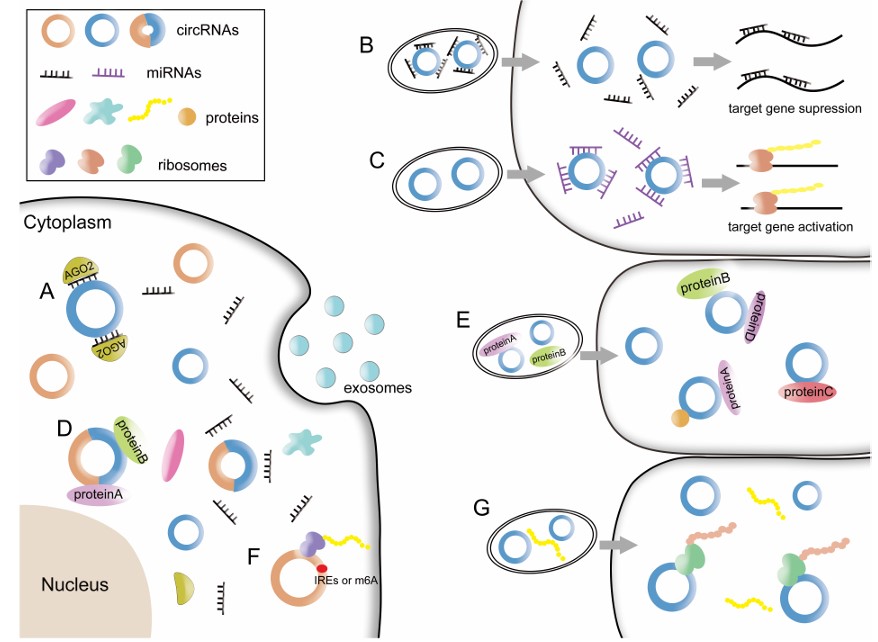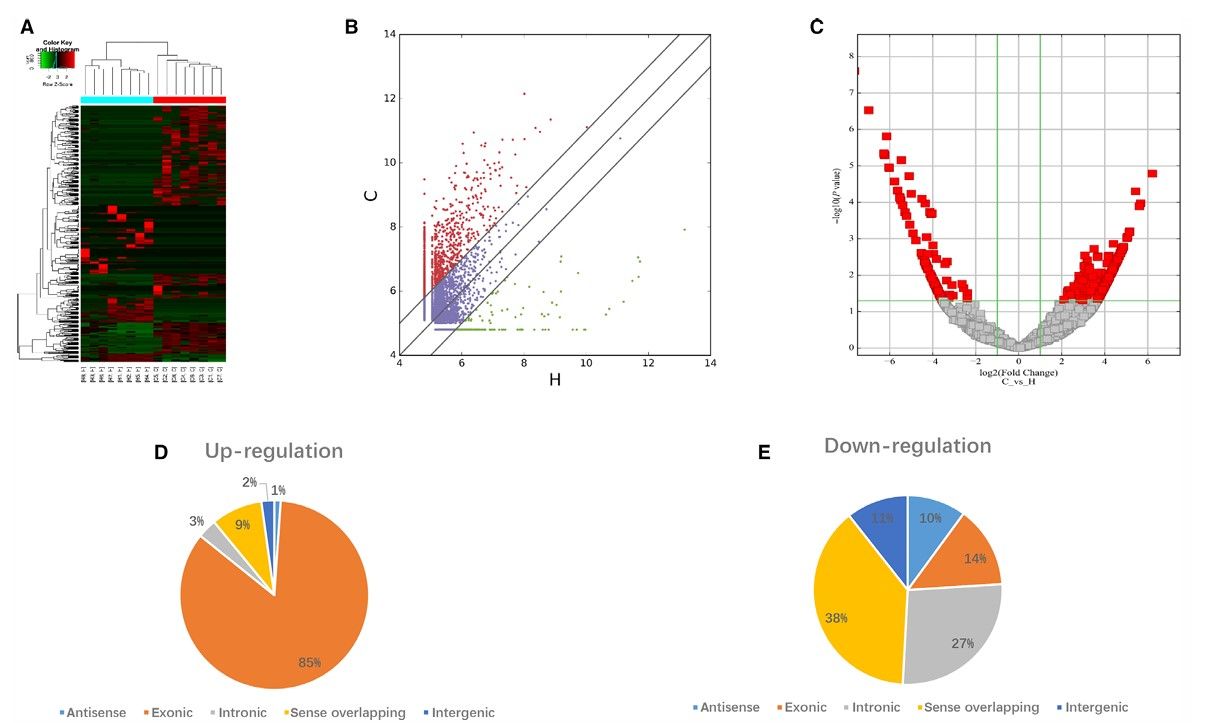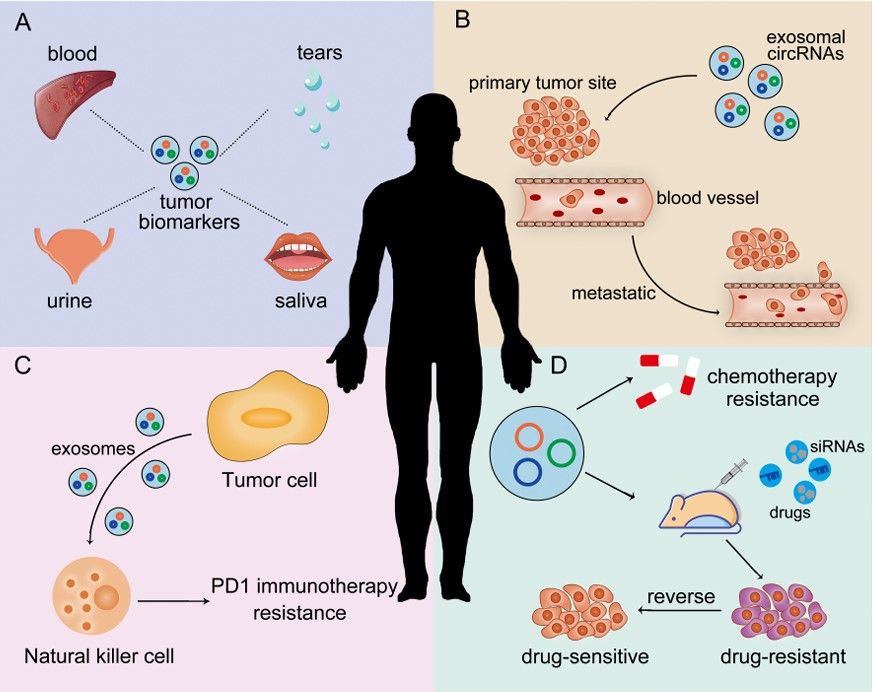Extracellular Vesicle circRNA Sequencing Service
Overview Services Features FAQs
circRNA Sequencing for EVs can shed light on the role of circRNAs in EV-mediated interactions and their abilities to regulate gene expression. Creative Biolabs provides the circRNA sequencing service for EVs, supporting clients to explore the advantages of EVs-based circRNAs as novel markers for development and application.
Introduction of circRNA in EVs
-
circRNAs can influence gene expression, bind to proteins, or attract other proteins to complexes. circRNAs can also act as translational templates to control the synthesis of proteins. For miRNAs that control target genes, circRNAs serve as sponges. circRNAs control the amounts of other RNAs directly using base complementary pairing.
-
The presence of circRNA in EVs has been identified, suggesting they may also be involved in EVs-mediated interactions. For example, circRNA is implicated in the transfer of miRNAs and mRNAs between cells, and therefore, circRNA may play an essential part in EV-mediated interactions that facilitate the transfer of intercellular molecules and thus have a broad impact on gene function and regulation. Accordingly, it has been proposed that circRNA in EVs acts in cancer, neurodegenerative diseases, and other disorders.
-
Based on the fact that EVs carry cirRNA to other cells, sequencing can identify circRNA involved in EV-mediated interactions and determine their role in regulating gene expression. In addition, it is also beneficial to explore the role of circRNA in other EVs-based mediated interactions, such as in protein, lipid, and nucleic acid transfer between cells. This serves as a data source for identifying novel regulatory pathways and networks involved in EV-mediated interactions, encouraging the advancement of alternative diagnostic biomarkers, approaches, and treatment targets.
 Fig. 1 Functions of circRNAs and exosomal circRNAs.1, 3
Fig. 1 Functions of circRNAs and exosomal circRNAs.1, 3
circRNA Sequencing Service for EVs at Creative Biolabs
circRNA sequencing for EVs is a type of RNA sequencing that is used to detect and quantify circRNAs in EV samples. Sequencing of circRNA for EVs can be performed with several technologies, including NGS, qPCR, and RT-qPCR. NGS allows high-throughput sequencing of circRNA and can be used to identify novel circRNAs and characterize their first structure and expression pattern. Quantifying the relative expression levels of circRNA at low abundance levels is possible using qPCR and RT-qPCR. By sequencing circRNA in EVs, researchers can investigate the expression of circRNA in EVs of different cellular and tissue sources, along with identifying novel circRNA.
 Fig. 2 Differential expression of circRNAs in EVs between patients with PDAC and healthy volunteers.2, 3
Fig. 2 Differential expression of circRNAs in EVs between patients with PDAC and healthy volunteers.2, 3
Features
-
Comprehensive circRNA Detection: Our service provides high-resolution circRNA sequencing specifically designed to identify and quantify circular RNAs present in EVs. This includes the ability to detect both known and novel circRNAs.
-
High Sensitivity and Specificity: Utilizing advanced sequencing technologies and bioinformatics tools, we ensure precise detection of low-abundance circRNAs and minimize background noise.
-
Tailored Sample Preparation: We offer specialized protocols for the isolation and purification of extracellular vesicles from various biological samples, ensuring optimal quality and yield of RNA.
-
Advanced Bioinformatics Analysis: Our service includes robust data analysis pipelines for circRNA annotation, quantification, and functional annotation, providing insights into circRNA expression profiles and their potential biological roles.
-
Expert Consultation: Access to a team of experts who can assist with study design, data interpretation, and troubleshooting to ensure the best outcomes for your research.
-
High-Throughput Capability: Our platform supports large-scale studies with the capability to handle multiple samples simultaneously, facilitating high-throughput circRNA analysis.
 Fig. 3 Clinical applications of exosomal circRNAs in anti-cancer therapy.1, 3
Fig. 3 Clinical applications of exosomal circRNAs in anti-cancer therapy.1, 3
circRNAs in EVs have excellent stability due to insensitivity to nucleases. In addition, circRNAs are conserved across species and serve as markers capable of responding to the origin and expression specificity of EVs at different developmental stages. Creative Biolabs is equipped with a proven RNA molecular sequencing platform to provide circRNA sequencing services for EVs, enabling the understanding of the composition and function of EVs circRNA. Please contact us with your interest.
FAQs
Q: How is circRNA sequencing different from traditional RNA sequencing?
A: circRNA sequencing is specifically designed to detect and analyze circular RNAs, which differ from linear RNAs in structure and biological function. Traditional RNA sequencing often focuses on linear RNA transcripts and may not efficiently capture circRNAs, which are less abundant and require specialized techniques for accurate detection.
Q: How do you guarantee that the results of the circRNA sequencing are accurate and of high quality?
A: We implement comprehensive quality control measures throughout the entire process, including sample preparation, sequencing, and data analysis. Our bioinformatics pipelines are validated to ensure accurate circRNA detection and quantification, and we perform extensive data validation to verify the results.
Q: What details will the completed report contain?
A: The final report includes detailed information on circRNA expression levels, differential expression analysis, and potential functional annotations. It is possible to build customized reports that highlight particular research-related areas of interest.
Q: Are there any unique guidelines for handling and gathering samples?
A: Yes, getting high-quality results requires careful sample handling and collection. We provide detailed guidelines for sample collection, storage, and shipment to ensure that the extracellular vesicles are preserved in optimal condition.
References
-
Xu, Yanhua, et al. "Exosomal circRNAs: sorting mechanisms, roles and clinical applications in tumors." Frontiers in cell and developmental biology 8 (2020): 581558.
-
Li, Qingqing, et al. "Circular RNA expression profiles in extracellular vesicles from the plasma of patients with pancreatic ductal adenocarcinoma." FEBS Open Bio 9.12 (2019): 2052-2062.
-
Under Open Access license CC BY 4.0. The image was modified by revising the title.
For Research Use Only. Cannot be used by patients.
Related Services:

 Fig. 1 Functions of circRNAs and exosomal circRNAs.1, 3
Fig. 1 Functions of circRNAs and exosomal circRNAs.1, 3
 Fig. 2 Differential expression of circRNAs in EVs between patients with PDAC and healthy volunteers.2, 3
Fig. 2 Differential expression of circRNAs in EVs between patients with PDAC and healthy volunteers.2, 3
 Fig. 3 Clinical applications of exosomal circRNAs in anti-cancer therapy.1, 3
Fig. 3 Clinical applications of exosomal circRNAs in anti-cancer therapy.1, 3








